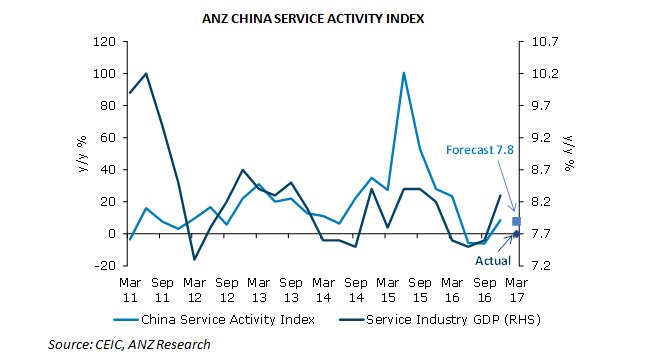-
China’s transformation into a services-led economy continues. In the first quarter of 2017 China reported stronger-than-expected headline gross domestic product data of 6.9 per cent.
" Is too early to conclude the notion of China as the ‘world’s factory’ has come to an end."
Raymond Yeung, Kaushik Baidya & Kanika Bhatnagar, Chief Economist, Greater China, Economist & Junior economist at ANZThe result was underpinned by strong growth in the service sector, which continues to outperform (up 7.7 per cent in the period) and contributed 62 per cent of the headline growth.
China’s government had previously projected the service sector would only reach this level of growth between 2021 and 2025, according to the China 2030 report published jointly with the World Bank.
The growing significance of the service industry in China can be gauged from its share in the economy.
In 2006, the industry accounted for 41.3 per cent of the GDP while the secondary industry accounted for 47.0 per cent.
The growth in the industry has picked up significantly in recent years and surpassed the secondary industry in 2012. In Q1, the service sector represented 57 per cent of the GDP, higher tan a decade ago by 16 percentage points.
The notion the expansion of the service sector is crucial for China’s economic advancement has been emphasised by the authorities on various occasions. In the aforementioned World Bank report the shift to high-value services was cited as a means to help avoid the middle-income trap.
In ANZ Research’s view, China’s growth sustainability is not measured or determined by the weighting of services in its GDP. Instead, productivity holds the key.
Deindustrialisation is not a solution for China to cope with external dependence and global uncertainty. Failure to boost service sector productivity will pose a drag on investment yield and weigh on the long-term outlook of real interest rates.
ACTIVITY
The growing influence of the service industry in China’s headline GDP has prompted us to develop an index to track its monthly performance.
The reality is the service sector comprises a wide range of activities, whose growth is underpinned by diverse drivers.
If the evolution of China’s service industry had simply followed conventional cyclical forces, its expansion would not have helped economic diversification.
Our index is constructed by tracking 16 indicators, covering a broad range of service sector activities. The index forecasts China’s service GDP should have grown by 7.8 per cent in Q1, close to the 7.7 per cent reported officially.
ANZ CHINA SERVICE ACTIVITY INDEX
{CF_IMAGE}
However, the service sector’s outlook is sensitive to China’s monetary conditions, given the high weighting of financial and real estate services at a combined 29 per cent.
The growth trajectories of both these two services are more volatile than other services, with financial deleveraging and property tightening wielding a large influence on their growth outlook in the near term.
FACTORY
At this stage, it is too early to conclude the notion of China as the ‘world’s factory’ has come to an end.
While China is still aiming to engineer the growth of the service industry to re-deploy laid-off workers from other industries, the government is also heavily promoting initiatives like “Made in China 2025”, embracing the global idea of “Industralisation 4.0”.
If China’s manufacturing industries are to successfully embrace the trend of automation and data exchange in manufacturing technologies, the country may be able to fire on both engines.
Raymond Yeung is Chief Economist, Greater China, Kaushik Baidya is an economist & Kanika Bhatnagar is a junior economist at ANZ
This story is an edited version of a report released by ANZ Research
The views and opinions expressed in this communication are those of the author and may not necessarily state or reflect those of ANZ.
-
EDITOR'S PICKS
-
Australia’s modern manufacturing sector carries with it an international reputation for quality and innovation.
3 May 2017 -
In her excellent and challenging book Happiness for All, Carol Graham uses the analogy of being stuck in traffic, with the lane next to you moving and yours not.
3 May 2017 -
When the US Federal Reserve raises interest rates we assume that means tighter financial conditions leading to a slower economy and knock-on impacts to the share market. However, reality is not quite that simple.
4 May 2017

